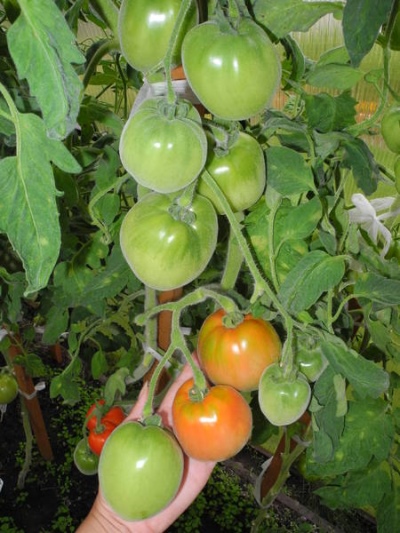
- Authors: Botyaeva G.V., Dederko V.N.
- Year of approval: 2007
- Category: grade
- Growth type: determinant
- Appointment: universal
- Ripening period: mid-season
- Growing conditions: for open ground, for film greenhouses, for growing on a windowsill
- Transportability: high
- Bush size: undersized
- Bush height, cm: up to 100
Scheherazade tomato is a versatile determinant variety suitable for growing on a windowsill, in open ground or in film greenhouses. Beautiful bushes with a plentiful crown look spectacular on a plot of any area, they can become a real decoration of the balcony. The tomato needs intensive care, requires special attention in the growing process.
Breeding history
The variety was bred by breeders from Novosibirsk Dederko V.N. and Botyaeva G.V. in 2007. Included in the State Register of the Russian Federation for certain regions.
Description of the variety
This variety is characterized by the height of the bushes up to 100 cm. The stems are strong, with velvety pubescence, have a bluish tint. The leaves are pendant, green, medium in size. The surface of the plate is densely pubescent. Inflorescences of a simple type, fruit clusters contain 4-5 tomatoes.
The main qualities of the fruit
Scheherazade tomatoes are large, weighing 200-300 g each. The velvety, slightly pubescent peel of ripe fruits is orange-red, unripe tomatoes are green, with a darker spot in the area of the stalk. The shape of the tomatoes is cylindrical, with a characteristic "spout", slightly reminiscent of a peach.
Taste characteristics
The tomatoes of this variety are sweetish, with a pleasant sourness. The pulp is of medium density, juicy, easy to bite. The fruits are suitable for preservation, drying, fresh, they are good in salads.
Ripening and fruiting
The variety is mid-season. On average, ripening occurs in 115-120 days. Fruiting is extended.
Yield
From sq. m, an average of 1.9 kg of tomatoes are harvested.
The timing of planting seedlings and planting in the ground
Seeds are sown 50-60 days before the planned transfer to a permanent place. For the period of germination, containers should be placed in places with a constant temperature of at least +23 degrees. The optimal sowing time is 1 or 2 ten days of March. The originator recommends pre-disinfecting seeds, using solutions such as humate or "Epin" for their preparation.

Growing tomato seedlings is an extremely important process, because it largely depends on whether the gardener will be able to harvest at all. All aspects must be taken into account, from seedbed preparation to planting in the ground.
Landing scheme
It is not recommended to exceed the placement density of 3 plants per 1 sq. m.

Growing and care
The variety requires the formation of a bush of 2-3 stems. Stepson and garter are also required. Without removing side shoots, you may encounter a decrease in the size of the fruit. Scheherazade's tomato does not like strongly acidified soils; in greenhouses, the soil is preliminarily disinfected. Outdoors, planting should be done in shaded areas, out of direct sunlight.
At the stage of obtaining seedlings, it is important to avoid waterlogging of the soil. Water it at the root, only after the topsoil has dried. After the emergence of seedlings, the plants change the temperature regime, maintaining the average values of the environment in the range of 16-18 degrees. The recommended daylight hours are 16 hours. Supplemental illumination with phytolamps is used as needed.
The grown bushes can be transferred to open ground only at the end of the night frost period. To the greenhouse - 1-2 weeks earlier. Seedlings are pre-fed with phosphorus, helping them to quickly increase the volume of the root system. Trellises or separate supports are placed in advance at the landing site, to which the garter will be made.




A plant needs different micronutrients at each stage of growth. All fertilizers can be divided into two groups: mineral and organic. Folk remedies are often used: iodine, yeast, bird droppings, eggshells.
It is important to observe the rate and period of feeding. This also applies to folk remedies and organic fertilizers.
Disease and pest resistance
Scheherazade has good resistance to late blight, root and apical rot. For other diseases, it is better to periodically spray plants with antifungal and antiviral drugs at least 3 times per season.


Resistant to adverse weather conditions
Tomato is poorly adapted to temperature extremes. It should be protected from frost and heat. With an increase in atmospheric temperatures, the variety ceases to form ovaries. Already pouring fruits begin to crack.
Growing regions
Tomatoes do not have restrictions on growing zones. They can be planted everywhere, from the Middle, Upper and Lower Volga regions to the Moscow region, the Urals, Siberia.
Review overview
Beautiful calibrated tomatoes of the Scheherazade variety managed to conquer summer residents throughout Russia. But not all vegetable growers are satisfied with the bushes themselves. It is noted that many seeds give much taller bushes - not determinant, but very high, up to 2 meters, with late fruit setting.It is possible that the misgrading is to blame for this, although the appearance of the plants and fruits corresponds to the description of the originator. It is also quite difficult to buy planting material, since the tomato is not very common.
The advantages of this variety include an unusual, very decorative appearance of shoots and leaves. And also the fruits are praised for their pleasant taste, sweet, juicy. It is noted that there are few fruits on the bush, there is no need for rationing the brushes. According to summer residents, the tomato is resistant to diseases, bears fruit for a long time, almost until the very frost, especially when planted in a greenhouse.

























































































